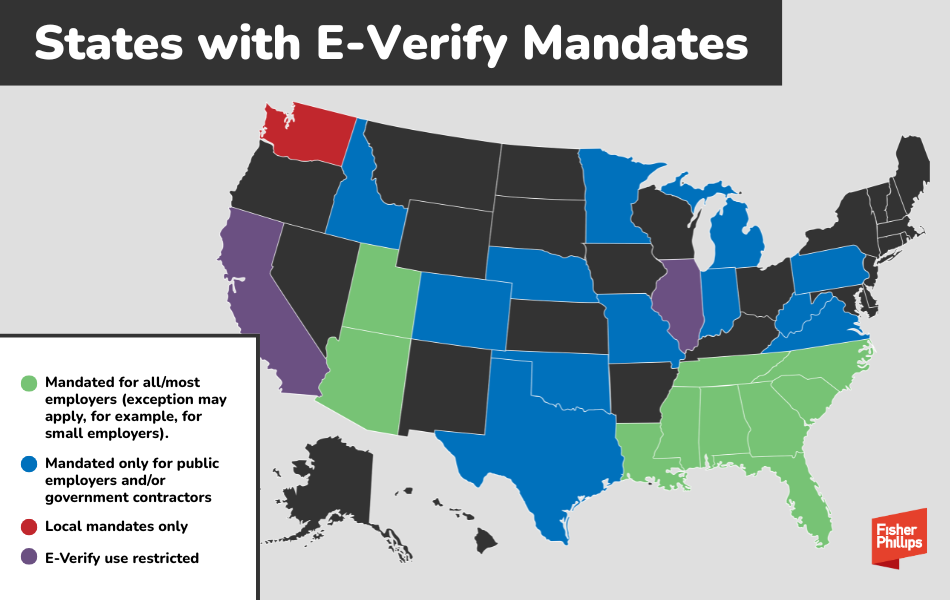Should Employers Use E-Verify for New Hires? Here Are 7 Pros and 7 Cons to Consider
Insights
9.10.25
Employers are required to verify that new hires are authorized to work in the US – and E-Verify offers a quick way to accomplish this task. The program, which matches I-9 data with the information in various government databases, aims to help employers stay compliant with federal employment and immigration regulations. But there are some issues you should note when deciding whether it’s right for your organization. Is E-Verify right for you? Consider these pros and cons before you incorporate it into your hiring process.
|
Quick Compliance Review
|
|
What is E-Verify?
|
7 Reasons Employers May Welcome E-Verify
1. Remote Verification: When completing Form I-9, employers generally must physically examine the employee’s identity and work authorization documents. Employers that are enrolled in E-Verify, however, are allowed to conduct document verification electronically rather than in person, so long as it’s done through a live video and certain other steps are followed. You can read more about electronic verification here.
2. Speed: Employers that use E-Verify receive an almost-immediate initial determination regarding a new employee’s authorization to work.
3. Good Faith Defense: When you confirm the identity and employment eligibility of newly hired employees using E-Verify procedures, you may rely on the system’s confirmation of their work authorized status, creating a presumption of good faith in the hiring process. This serves as an extra layer of protection and confidence when it comes to compliance.
4. Easy Integration: E-Verify can be integrated into an employer’s existing onboarding and HR processes and can also be accessed online.
5. Extra Options for Hiring Foreign Nationals: Employers that are enrolled in E-Verify can hire foreign students on F-1 visas for an additional period of two years for Science, Technology, Engineering, and Mathematics (STEM) positions.
6. Government Benefits: Depending on the state, employers may receive state contracts, grants, or incentives for using E-Verify. Additionally, enrollment in E-Verify is a requirement for being awarded certain federal government contracts.
7. Your State May Require It: Some states, like Arizona, require all private employers to use E-Verify. Other states, such as Florida, exclude smaller businesses – and some mandate it only for public employers and contractors. Be sure to check the rules in your locations.
7 Reasons You May Want to Skip It
1. Use of Resources: Employers will need to learn how to use E-Verify, stay up to date with ever-changing regulations, and ensure their IT systems can manage the process and keep up with changes.
2. False Positives and Negatives: E-Verify is not foolproof, and it can produce errors. The system may sometimes flag individuals who are authorized to work (false positives) or fail to identify unauthorized workers (false negatives).
3. Privacy Concerns: E-Verify involves the collection and storage of sensitive personal information, such as Social Security numbers. This has raised concerns about privacy and the potential for identity theft or misuse of this information.
4. Extra Management: Employers that use E-Verify must consistently use the system for all employees and subject themselves to ICE audits to verify both I-9 and E-Verify compliance. Using E-Verify does not decrease the chance of an I-9 audit.
5. Government Shutdown: Employers should consider recent and future threats of government shutdowns, as E-Verify is not available while the federal government is not operating. Although E-Verify will be available once a shutdown ends, there is a period where employers may not submit data.
6. Reliance on Technology: As a web-based service, E-Verify requires access to reliable internet, certain software, and a printer.
7. A State Trend is Brewing to Restrict It: Notably, California and Illinois impose certain restrictions on E-Verify use. Other states may follow suit, particularly as tension builds between blue states and the federal government’s immigration stance.
What’s Next?
You should note that the Department of Homeland Security and Social Security Administration rolled out an E-Verify+ pilot program in 2024. The goal is to reduce the burden on employers by combining aspects of the I-9 and E-Verify systems into a single, unified process. In addition, the responsibility for accurate data input will be shifted to employees.
While many employers can opt to participate now, E-Verify+ is not yet available for Web Services or E-Verify Employer Agents, including PEOs.
If you are considering using E-Verify or E-Verify+, it’s a good idea to reach out to experienced counsel to weigh the pros and cons specifically for your business operations.
Conclusion
Fisher Phillips will continue to monitor E-Verify and I-9 Form developments and will provide additional guidance as it becomes available. Make sure you are subscribed to Fisher Phillips’ Insight System to get the most up-to-date information and invitations to our webinars. If you have further questions, contact your Fisher Phillips attorney, the authors of this Insight, or any attorney on our Immigration Practice Group.
Related People
-
- David S. Jones
- Regional Managing Partner
